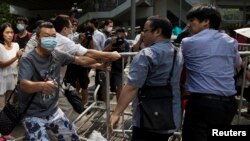Police in Hong Kong are for a second day trying to remove barricades set up by pro-democracy protesters who have spent weeks demonstrating for democratic reforms.
Witnesses in the city say the police effort Tuesday appears to be aimed at opening up traffic lanes along the edges of the demonstration site, in the busy Causeway Bay shopping district.
Police began removing barricades on Monday, although demonstrators say police are not forcing them to leave. Witnesses say demonstrators at the main protest site in Admiralty are trying to reinforce their site by laying new cement.
Also Monday, hundreds of people, some of them wearing masks and wielding knives, confronted the protesters, trying to break down their barricades. Some drove a crane towards the barricades, leading to a tense stand-off.
Police eventually pushed back the anti-occupy protesters and there were no reported injuries.
Taxi drivers are also expressing their opposition to the protesters by honking their horns and yelling at them.
Amid the chaos, 66-year-old Richard Chung said democracy activists were ruining the city.
"I am here because I am not satisfied," Chung said. He said the demonstrators "are here on behalf of us. They are affecting our life; affecting a lot of people. They want to go back to work. I think democracy [should not be] like this. Don’t do harm to others.”
Legislator Leung Kwok-hung of the League of Social Democrats alleged the knife-wielding men among the anti-Occupy protesters were in the paid service of pro-Beijing interests and compared their actions to those of pro-Ceausescu forces during the Romanian revolution.
"Beijing really wants to use Triads and to mobilize the mob," said Leung. "They want to repeat what happened in Romania in 1990. At that time, the communist regime sent the miners to the capital to crush the student movement. I think they’re trying to repeat [this].”
With nightfall, the situation began to settle. Police withdrew from the streets and students replaced barricades in areas from which they were forced to retreat during the day.
While the protesters remain defiant, Hong Kong leader Leung Chun-ying attended the Pearl River Delta development forum across the Chinese border Monday.
Another attendee was believed to be the chairman of the National People’s Congress standing committee Zhang Dejiang, one of China’s most senior leaders.
According to China political expert Professor Willy Lam of Chinese University of Hong Kong, Zhang would no doubt have orders for the beleaguered Hong Kong chief executive on how to diffuse the political standoff, while upholding the central government’s August 31 decision to allow only vetted candidates to stand for the chief executive election in 2017 - a catalyst for the protests.
“For the time being, it looks like Beijing will stick to its early instruction of no compromise, no bloodshed," said Lam. "This means no compromise on the August 31 decision. But at the same time, they have urged the Leung administration to avoid bloodshed even if the Hong Kong administration were to decide to use so-called minimum force to remove the protesters."
While Monday marked the beginning of the third week of the Hong Kong democracy protests, it also marked the 18th birthday of one of the principal leaders of the Occupy Movement, Joshua Wong.
His three birthday wishes, posted on Facebook early Monday morning, are for the protests to remain peaceful, the protesters to maintain their spirits, and for Beijing to withdraw its strict electoral reform package and allow universal suffrage in Hong Kong.










